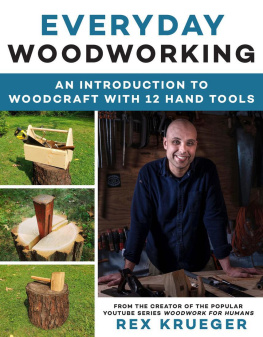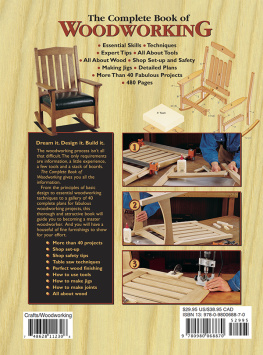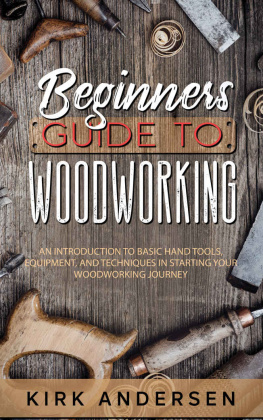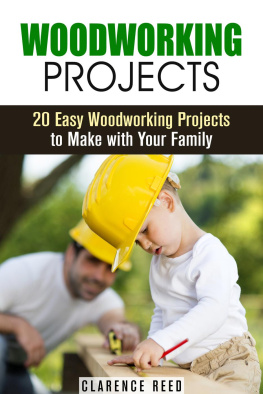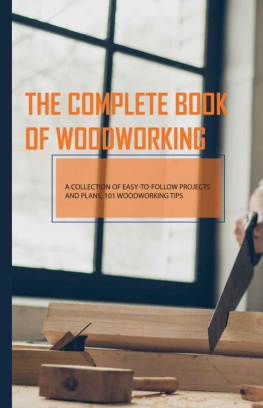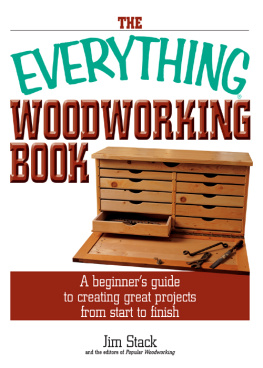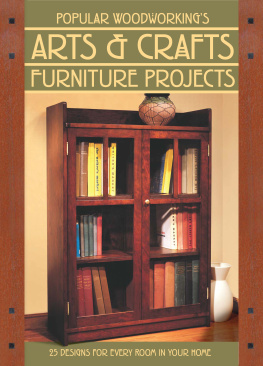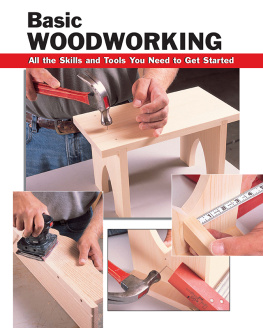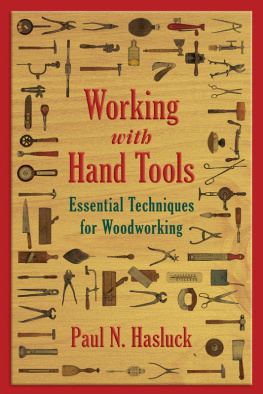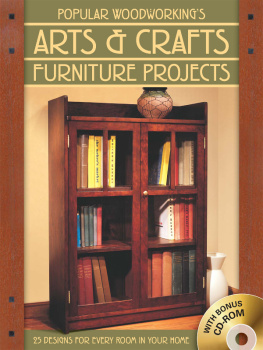Acknowledgements
The publication of The Everything Woodworking Book would not be possible if it werent for the following people and companies:
Jim Stack
Popular Woodworking books and magazines
The authors and contributors of Popular Woodworking books and magazinesin particular: Jennifer List, Bill Hylton, Mag Ruffman, David Thiel, Jim Stuard, and Christopher Schwarz
F+W Publications, Inc.
Thank you!
The Everything Woodworking Book
I started woodworking about 100 years ago (or so it seems) when I was fi ve years old. I went down into the basement of our house where my dad had a small woodworking shop. I grabbed a handsaw and proceeded to cut some really cool-looking (at least I thought so) slots into the front edge of my dads bench. Then, to add to my little project, I found a hammer and some nails.
I pounded and pounded until I had installed about a dozen or so nails into the top of the bench.
My dad wasnt as excited as I was about my project, but he didnt discourage me from working in his shop. He got some scraps of wood and showed me how to use his hand tools. I was allowed to go into the shop whenever I wanted.
A few years later, when my woodworking skills had improved, I hand-cut dados, mor tises, and tenons in the base of the bench and rebuilt it. I reset the top boards (they were from some old ammunition boxes) and it was like new. For the record, the nails and saw cuts are still in the bench.
I hope that your own adventures in woodworking start out a little more successfully, but end just as happily and productively, as mine have.

The EVERYTHING Series
Editorial
| Publishing Director | Gary M. Krebs |
| Managing Editor | Kate McBride |
| Copy Chief | Laura M. Daly |
| Acquisitions Editor | Courtney Nolan |
| Development Editor | Larry Shea |
| Production Editor | Jamie Wielgus |
Production
| Production Director | Susan Beale |
| Production Manager | Michelle Roy Kelly |
| Series Designers | Daria Perreault Colleen Cunningham |
| Cover Design | Paul Beatrice Matt LeBlanc |
| Layout and Graphics | Colleen Cunningham Daria Perreault |
| Composition and Interior Design | Electronic Publishing Services, Inc. |
| Series Cover Artist | Barry Littmann |
Visit the entire Everything Series at www.everything.com
PART ONE
Woodworking Tools, Materials, and Techniques
chapter 1 wood
chapter 2 tools
chapter 3 fasteners, hardware, and glues
chapter 4 sanding and finishing
chapter 5 woodworking safely
chapter 6 joinery
chapter 7 setting up your shop
chapter 8 planning your projects
Chapter 1
Wood
M uchmaybe even mostof the reason generation after generation of woodworkers has become obsessed with this craft is the remarkable material you get to work with. Even after youve chosen one of the many varieties availablepine? oak? how about bubinga?youll find that each individual piece of wood has its own unique color, pattern, characteristics, and feel. As a natural material, wood carries with it the history of decades or even centuries of growth. No other material that you can create beautiful and functional objects from also gives you the same deep connection to the natural world. (This is just one reason, no doubt, you are reading this book, and not, say, something like The Everything Plastic-working Book.)
Because it is a natural material, wood requires special strategies to work with it successfully. Youll find that its habit of expanding and contracting, for example, doesnt stop even after a tree becomes a tabletop. In this chapter, well discuss what kinds of wood you can choose from, where and how to buy wood, and what you need to know about wood itself in order to create enduring objects from this irresistible material.
> Types of Wood
More than 100 wood species are available in the United States, with about 60 native woods sold commercially. Thats a lot of wood for woodworkers to choose from, and the right choice for a project might not always be the first wood that catches your eye, or the one that is most easily available.
Trees, and the wood they provide, are generally divided into two very broad, and sometimes confusing, classes: hardwoods and softwoods. The distinction between the two categories is based on the way in which the two types of trees grow. The confusion comes from the fact that there are several softwoods that are actually harder than some hardwoods. Southern yellow pine, for example, is a softwood with wood that is harder than basswood, a hardwood.
hardwoods
Hardwoods are deciduous trees with broad leaves. Trees that are hardwoods produce a fruit or a nut and usually go dormant (lose their leaves) in the winter. Hardwoods are also porous, meaning they contain wood cells with open ends called vessel elements that serve as conduits for transporting water or sap in the tree.
Some examples of hardwoods grown in the United States are oak, ash, cherry, maple, and poplar. Most imported tropical woods, sometimes called exotic woods, are also hardwoods. These imports include some varieties youve probably heard of, such as rosewood, teak, mahogany, and ebony. The names of some other varieties of imported woods may be familiar only to serious woodworkers (and maybe to game-show champions); these include woods such as bubinga, purpleheart, padauk, and cocobolo. For your own woodworkingwhether it be furniture making, cabinetmaking, built-in projects, paneling, or architectural woodworkyou will more likely be using domestic hardwoods such as cherry or oak. However, you may want to consider incorporating small amounts of the more exotic (and pricier) imported woods in your projects for such elements as drawer fronts or pulls, decorative strips, door panels, or other accents.
softwoods
Softwoods are generally evergreen conifers, meaning they are cone-bearing. Softwoods are nonporous, meaning they do not contain the vessel elements found in hardwoods.
Softwoods are generally used in the construction of flooring and molding, but also in paneling and cabinetry work. The most common U.S. softwoods available include cedar, fir, hemlock, pine, redwood, and spruce. Most of the lumber you will see at your nearby home center will be varieties of softwoods, especially pine. Speaking very generally, softwoods tend to be less expensive than hardwoods, as well as lighter. That is to say, if you go to a building-supply store to get a pine board and an oak board of the exact same dimensions, the oak board will probably cost more money and require more effort to lift onto your cart. The comparative costs of all woodswhether hardwoods or softwoodscan vary greatly, though, depending on the particular variety of wood, the quality of the individual piece, and where you are buying it.
If you are a beginning woodworker, there are several reasons you may decide to start off by working with boards of softwoods such as pine. Pine is widely available, is lower in cost than many other woods, and can be easier to cut and shape because of its softness. It is less durable than hardwoods such as oak and cherry, though, and it is more likely to splinter or chip as you are working with it. Hardwoods often have more interesting grain patterns and more varied colors as well.


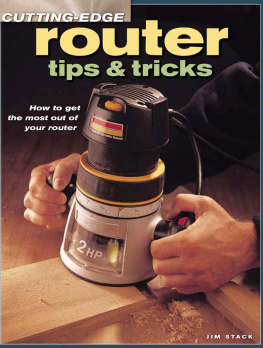
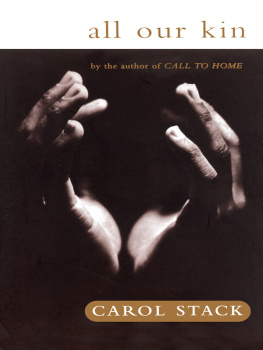


![Stack - It is just you, everythings not shit: [a guide to all things nice]](/uploads/posts/book/253795/thumbs/stack-it-is-just-you-everything-s-not-shit-a.jpg)

